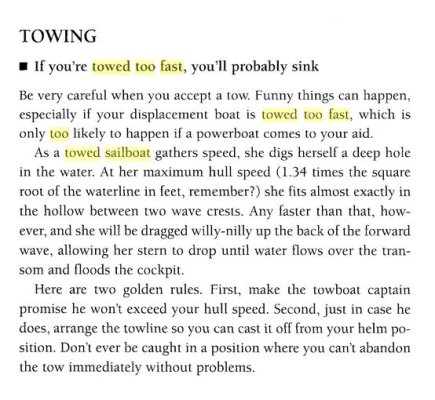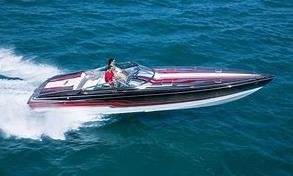Riverguy
Senior Member
- Joined
- Feb 17, 2013
- Messages
- 285
- Location
- USA
- Vessel Name
- Serendipitous
- Vessel Make
- Mainship 390, Bayliner 3258, Bayliner 4788
Do we now need a definition of 'possible'?
Why keep resorting to the ridiculous to prove a ridiculous assertion?
No, it's not 'possible', because (apart from being ridiculous), the combined weight of the engine >>and<< fuel for the power source you 'already referenced' would, would (a) sink the boat instantly before the engine starts, and (b) fuel would be totally consumed in less than 9 seconds. During that nine seconds, the boat would still not plane, it would sink, the same as it would if it was simply towed too fast. Also, you didn't include the weight of the "100,000 hp fuel pumps" in your calculation.
Maybe we could use a definition of 'possible' that means "possible in the real world".
re: "I said a displacement hull can be made to exceed "hull speed" by applying enough power. Pretty much every NA will agree with me on that."
Of course we'd agree, because it's a platitude. I'm not challenging that. If you read more carefully...I was responding to your subsequent post...where you said: "most normal hull shapes will eventually plane". A full-displacement hull is definitely a 'normal' shape and it will definitely never plane. Just like a sailboat being towed too fast, it will sink before it planes.
2) Re: "What do you mean when you say "planing"?
I attached a link to a definition from boatdesign.net in my post, maybe you didn't catch that? You should check out that website. There are real naval architects there.
3) Re: "sailboats...and on the face of a wave will do a pretty good job of planing."
Also false, and yet another ridiculous analogy. Think. If the force of gravity is no longer perpendicular to the water on which you are 'planing' (as it will be on the face of a wave), then the upward forces on the hull (hydrodynamic and bouyancy) will be less than the downward force of gravity on the boat. In this state the boat will be 'falling' down the surface of the water. On a hull that is capable of planing, this is known as surfing. Now...as the face of the wave approaches vertical, the weight of the boat relative to the wave's surface approaches zero. So...falling is not planing, and we don't need a definition to know that. It occurs to me that if you had actually experienced this, you'd already know that you were falling because you can feel it in your stomach, just like you can anytime you lose altitude rapidly.
Now...setting aside all of the impossible nonsense scenarios, here is why a full displacement hull can NEVER plane:
Yes that boat in the picture can be made to do that. It isn't practical, but it is possible. I've already referenced the power source that will do it. 418,000 lbs of thrust, weighs only 7700 lbs. The fuel pumps alone generate nearly 100,000 hp. Mileage will be poor though.
Why keep resorting to the ridiculous to prove a ridiculous assertion?
No, it's not 'possible', because (apart from being ridiculous), the combined weight of the engine >>and<< fuel for the power source you 'already referenced' would, would (a) sink the boat instantly before the engine starts, and (b) fuel would be totally consumed in less than 9 seconds. During that nine seconds, the boat would still not plane, it would sink, the same as it would if it was simply towed too fast. Also, you didn't include the weight of the "100,000 hp fuel pumps" in your calculation.
Maybe we could use a definition of 'possible' that means "possible in the real world".
re: "I said a displacement hull can be made to exceed "hull speed" by applying enough power. Pretty much every NA will agree with me on that."
Of course we'd agree, because it's a platitude. I'm not challenging that. If you read more carefully...I was responding to your subsequent post...where you said: "most normal hull shapes will eventually plane". A full-displacement hull is definitely a 'normal' shape and it will definitely never plane. Just like a sailboat being towed too fast, it will sink before it planes.
2) Re: "What do you mean when you say "planing"?
I attached a link to a definition from boatdesign.net in my post, maybe you didn't catch that? You should check out that website. There are real naval architects there.
3) Re: "sailboats...and on the face of a wave will do a pretty good job of planing."
Also false, and yet another ridiculous analogy. Think. If the force of gravity is no longer perpendicular to the water on which you are 'planing' (as it will be on the face of a wave), then the upward forces on the hull (hydrodynamic and bouyancy) will be less than the downward force of gravity on the boat. In this state the boat will be 'falling' down the surface of the water. On a hull that is capable of planing, this is known as surfing. Now...as the face of the wave approaches vertical, the weight of the boat relative to the wave's surface approaches zero. So...falling is not planing, and we don't need a definition to know that. It occurs to me that if you had actually experienced this, you'd already know that you were falling because you can feel it in your stomach, just like you can anytime you lose altitude rapidly.
Now...setting aside all of the impossible nonsense scenarios, here is why a full displacement hull can NEVER plane:




 Do they plane... Bet they all are FD!!
Do they plane... Bet they all are FD!!
